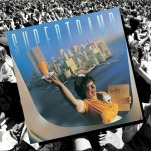Better Late Than Never: Watchmen
Throughout my tenure at The A.V. Club, I have cheekily proposed running a story titled, “Comic books: now they’re just for kids!” to lampoon the endless deluge of well-intentioned but thoroughly bone-headed “Comic books: they aren’t just for kids anymore!” articles that still pop up in newspapers and magazines. By now, it’s old news that the comic books can tackle subject matter more mature and nuanced than Jughead’s love of burgers and Scrooge McDuck’s periodic swims in his money vault.
It is no exaggeration to call Watchmen creator Alan Moore and The Dark Knight Returns author Frank Miller two of the architects of contemporary pop culture. A quick trip to the multiplex confirms that we are living in an age of comic-book deconstruction. Christopher Nolan’s brooding The Dark Knight—which follows in the footsteps of Miller’s seminal The Dark Knight Returns, though Miller’s even more radical script for a Batman movie was rejected by a squeamish studio—is within range of becoming the top-grossing film of all time. Hancock daringly cast Will Smith as a drunken, misanthropic superhero and eschewed the cornball Americana and sweeping vistas of Superman in favor of handheld cameras and a gritty cinéma vérité aesthetic, yet still made hundreds of millions at the box office. Even the summer’s lightest, goofiest superhero movie, Hellboy II: The Golden Army, features an unlikely protagonist who’s literally the spawn of the devil.
These days, it’s square old Superman, with his retro love for truth, justice, and the American Way, who’s the anomaly, not dark, tormented weirdoes who put on ridiculous costumes and combat internal demons as much as supervillains.
Much of this shift can be attributed to a single masterpiece: Alan Moore and Dave Gibbons’ Watchmen. Of course, Moore didn’t invent the dark, troubled superhero. He was working with archetypes based on specific pre-existing characters, in this case derived mainly from the roster of Charlton Comics, a long-suffering publisher that had recently been absorbed by Moore’s then-employer DC Comics. But Moore took the bleakness, neuroses, brooding philosophy, and nihilism that had been coursing through comic books for decades, and elevated the form to high art, something for the smart set and the post-grads as well as comic-book nerds and pimply teens. With Watchmen, he set out to write a comic-book series with the depth and heft of a Moby Dick. Audacious? Sure. Pretentious? Probably. Did he succeed? Indubitably. At the risk of being slightly hyperbolic, Watchmen is such a monumental achievement that it makes Moby Dick look like a flaming pile of horseshit by comparison.
Though Zack Snyder’s Watchmen isn’t scheduled for release until 2009, Watchmen-mania has swept the nation. The Internet is going nuts with frenzied debate as to whether the film’s trailer is the worst thing that’s ever happened in America, or a harbinger of greatness. So I figured now would be a perfect time to fill in one of the gaping chasms in my cultural education.
Why hadn’t I read Watchmen until about a month ago? Let’s just say I’m too busy getting laid, sky-diving, leading training drills for my private army like the big homey Mishima, and savoring fine wines and Cuban cigars to waste my precious, precious time reading funny animal stories and picture-books about grown men who dress up like animals to fight crime. No, that’s not even remotely true. I am a huge fucking geek, but I am not, alas, a comic-book geek. I like comic books, but I’m a hopeless neophyte where the medium is concerned. I’ve read a smattering of the classics—some Miller, a little Dan Clowes, some Chris Ware—but that’s about as far as my comic-book education goes. So it would be wise to take everything I say about comic books with a grain of salt. Actually, that’s not bad advice regarding everything I write.
Watchmen takes place in a 1980s where the United States won Vietnam, Richard Nixon is still President—having kicked that whole two-term limitation thing to the curb—and superheroes, or “Costumed Adventurers,” as they’re more commonly, accurately known, have been outlawed by the 1977 Keene Act.
The exceptions are a pair of shadowy figures who now toil for the government: Dr. Manhattan, an enigmatic blue figure born Jonathan Osterman, who attained godlike power during a scientific experiment gone horribly awry, and The Comedian, an arch-nihilist with Errol Flynn’s dashing good looks and the Joker’s winning way with people and conception of life as a killing joke with no punchline. The Comedian is a rapist and murderer as well as an honored government agent.
Dr. Manhattan’s superpowers have given the United States a distinct strategic advantage in its Cold War with the Russians. He’s a one-man nuclear deterrent, a figure of bottomless power and profound angst. Though he lives with Laurie Juspeczyk, who moonlights as the second incarnation of a costumed adventurer named Silk Spectre (her bawdy mother was the first), he’s an existential nowhere man. His bottomless power has alienated him from humanity and the world around him. Though lionized and feared, he is utterly alone. His intelligence has cut him off from his emotions; he tends to see everything as an abstract intellectual problem in a largely meaningless world where time is no longer linear, but circles endlessly upon itself. Needless to say, he wouldn’t be much fun to grab a beer with.


















![Rob Reiner's son booked for murder amid homicide investigation [Updated]](https://img.pastemagazine.com/wp-content/avuploads/2025/12/15131025/MixCollage-15-Dec-2025-01-10-PM-9121.jpg)





















